Page 301 of 418
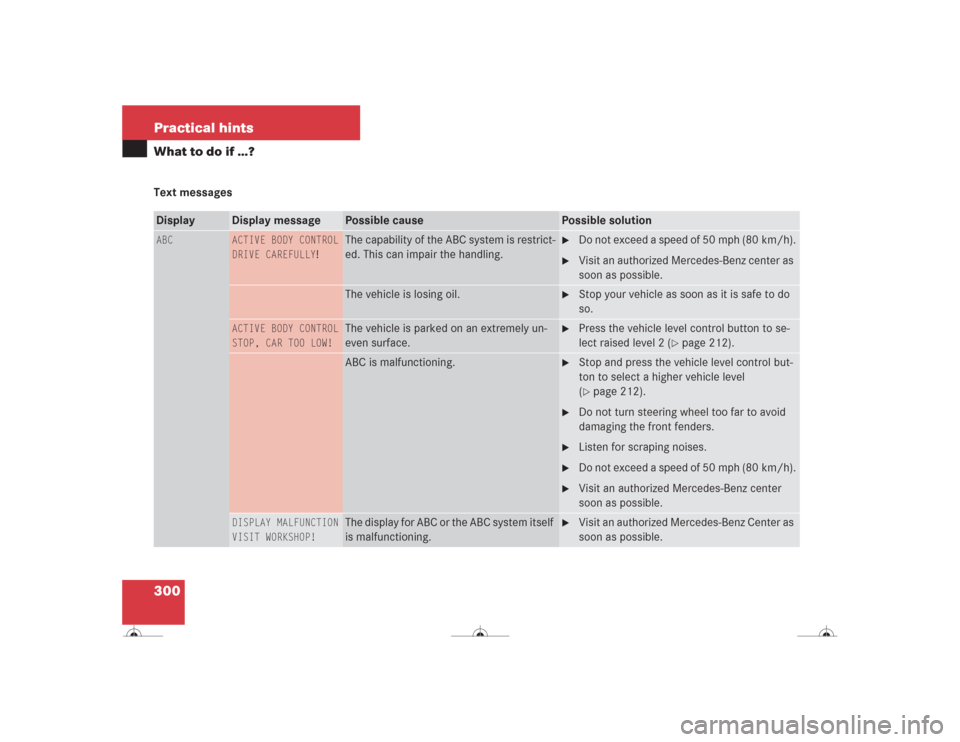
300 Practical hintsWhat to do if …?Text messagesDisplay
Display message
Possible cause
Possible solution
ABC
ACTIVE BODY CONTROL
DRIVE CAREFULLY
!
The capability of the ABC system is restrict-
ed. This can impair the handling.
�
Do not exceed a speed of 50 mph (80 km/h).
�
Visit an authorized Mercedes-Benz center as
soon as possible.
The vehicle is losing oil.
�
Stop your vehicle as soon as it is safe to do
so.
ACTIVE BODY CONTROL
STOP, CAR TOO LOW!
The vehicle is parked on an extremely un-
even surface.
�
Press the vehicle level control button to se-
lect raised level 2 (
�page 212).
ABC is malfunctioning.
�
Stop and press the vehicle level control but-
ton to select a higher vehicle level
(�page 212).
�
Do not turn steering wheel too far to avoid
damaging the front fenders.
�
Listen for scraping noises.
�
Do not exceed a speed of 50 mph (80 km/h).
�
Visit an authorized Mercedes-Benz center
soon as possible.
DISPLAY MALFUNCTION
VISIT WORKSHOP!
The display for ABC or the ABC system itself
is malfunctioning.
�
Visit an authorized Mercedes-Benz Center as
soon as possible.
Page 304 of 418
303 Practical hints
What to do if …?
Display
Display message
Possible cause
Possible solution
ESP
NOT AVAILABLE!
SEE OPER. MANUAL
The ESP was deactivated the power supply
has been interrupted.
The ABS is still operational.
�
Synchronize the ESP. With the vehicle sta-
tionary and the engine running, turn the
steering wheel completely to the left and
then to the right to synchronize the ESP.
If the ESP message does not go out:
�
Continue driving with added caution.
�
Have the system checked at an authorized
Mercedes-Benz Center as soon as possible.
Failure to follow these instructions increases the
risk of an accident.
!When synchronizing the ESP, make
sure you can turn the steering wheel in
both directions as far as it will go with-
out the wheel hitting any objects, e.g.
aroad curb.
Page 313 of 418
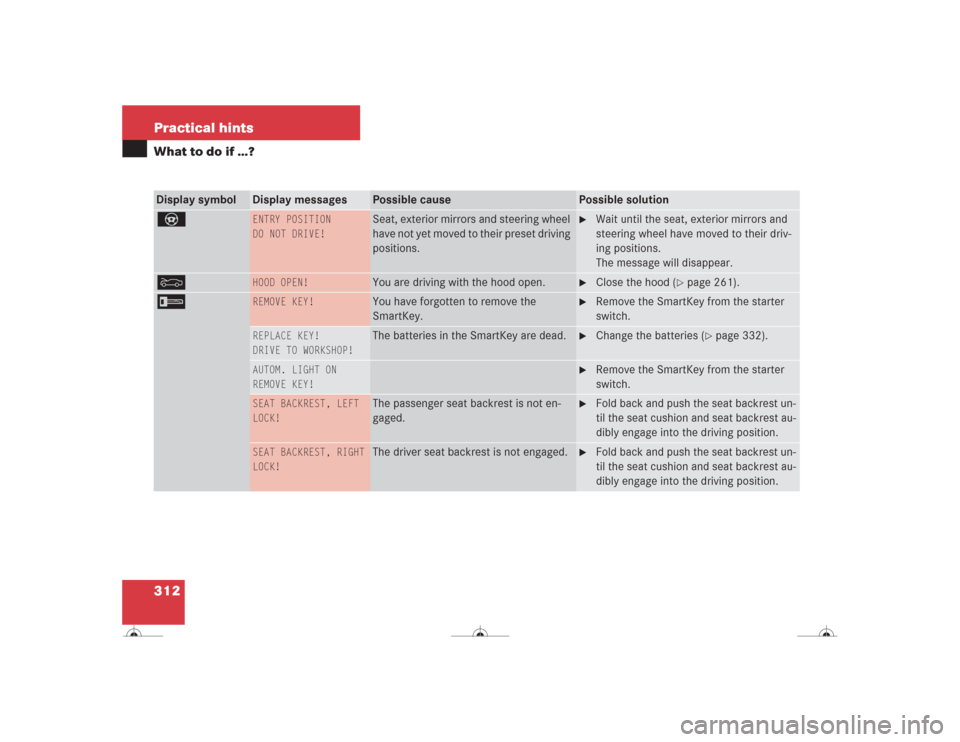
312 Practical hintsWhat to do if …?Display symbol
Display messages
Possible cause
Possible solution
_
ENTRY POSITION
DO NOT DRIVE!
Seat, exterior mirrors and steering wheel
have not yet moved to their preset driving
positions.
�
Wait until the seat, exterior mirrors and
steering wheel have moved to their driv-
ing positions.
The message will disappear.
Y
HOOD OPEN!
You are driving with the hood open.
�
Close the hood (
�page 261).
I
REMOVE KEY!
You have forgotten to remove the
SmartKey.
�
Remove the SmartKey from the starter
switch.
REPLACE KEY!
DRIVE TO WORKSHOP!
The batteries in the SmartKey are dead.
�
Change the batteries (
�page 332).
AUTOM. LIGHT ON
REMOVE KEY!
�
Remove the SmartKey from the starter
switch.
SEAT BACKREST, LEFT
LOCK!
The passenger seat backrest is not en-
gaged.
�
Fold back and push the seat backrest un-
til the seat cushion and seat backrest au-
dibly engage into the driving position.
SEAT BACKREST, RIGHT
LOCK!
The driver seat backrest is not engaged.
�
Fold back and push the seat backrest un-
til the seat cushion and seat backrest au-
dibly engage into the driving position.
Page 320 of 418
319 Practical hints
What to do if …?
Display symbol
Display messages
Possible cause
Possible solution
t
FUNCTION
NOT AVAILABLE!
This display appears if button t or
son the multifunction steering wheel
is pressed and the vehicle is not equipped
with a telephone.
Ê
TRUNK OPEN!
This message will appear whenever the
trunk lid is open.
�
Close the trunk lid.
W
WASHER FLUID
CHECK LEVEL!
The fluid level has dropped to about
1/3
of total reservoir capacity.�
Add washer fluid (
�page 269).
Warning!
G
Do not spill antifreeze on hot engine parts.
Antifreeze contains ethylene glycol which
may burn if it comes into contact with hot
engine parts. You could be seriously burned.
Page 322 of 418

321 Practical hints
What to do if …?
Display symbol
Display message
Possible cause
Possible solution
H
TIRE PRES. MONITOR
REACTIVATE!
The tire inflation pressure monitor* is de-
activated.
�
Activate the tire inflation pressure mon-
itor* (
�page 274).
TIRE PRES. MONITOR
VISIT WORKSHOP!
The tire inflation pressure monitor* is
malfunctioning.
�
Have the tire inflation pressure moni-
tor* checked by an authorized
Mercedes-Benz Center.
�
Change the wheel (
�page 343).
A wheel without proper sensor was in-
stalled.
�
Check and correct tire pressure as re-
quired (
�page 271).
TIRE PRES.
CAUTION, TIRE DEFECT!
One or more tires are deflating.
�
Carefully bring the vehicle to a halt,
avoiding abrubt steering and braking
maneuvers.
�
Change the wheel (
�page 343).
TIRE PRES.
CHECK TIRES!
The tire pressure in one or more tires is
already below the minimum value.
The tire pressure in one or more tires is
low.
�
Carefully bring the vehicle to a halt,
avoiding abrubt steering and braking
maneuvers.
�
Change the wheel (
�page 343).
Warning!
G
Do not drive with a flat tire. A flat tire affects
the ability to steer or brake the vehicle.
You may lose control of the vehicle. Contin-
ued driving with a flat tire will cause exces-
sive heat build-up and possibly a fire.
Page 323 of 418
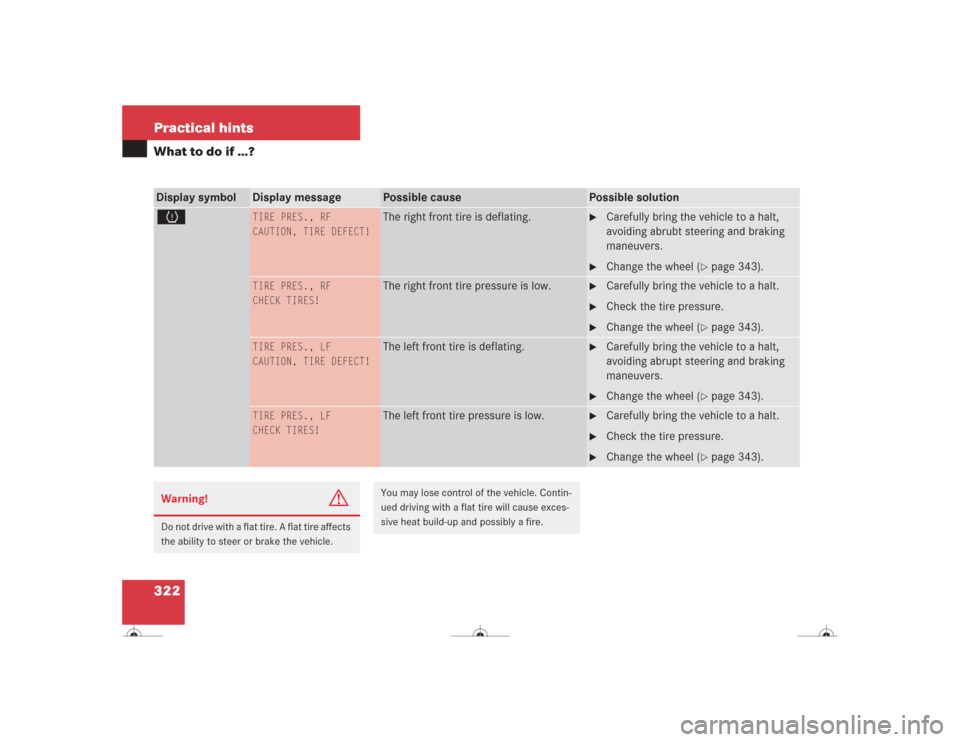
322 Practical hintsWhat to do if …?Display symbol
Display message
Possible cause
Possible solution
H
TIRE PRES., RF
CAUTION, TIRE DEFECT!
The right front tire is deflating.
�
Carefully bring the vehicle to a halt,
avoiding abrubt steering and braking
maneuvers.
�
Change the wheel (
�page 343).
TIRE PRES., RF
CHECK TIRES!
The right front tire pressure is low.
�
Carefully bring the vehicle to a halt.
�
Check the tire pressure.
�
Change the wheel (
�page 343).
TIRE PRES., LF
CAUTION, TIRE DEFECT!
The left front tire is deflating.
�
Carefully bring the vehicle to a halt,
avoiding abrupt steering and braking
maneuvers.
�
Change the wheel (
�page 343).
TIRE PRES., LF
CHECK TIRES!
The left front tire pressure is low.
�
Carefully bring the vehicle to a halt.
�
Check the tire pressure.
�
Change the wheel (
�page 343).
Warning!
G
Do not drive with a flat tire. A flat tire affects
the ability to steer or brake the vehicle.
You may lose control of the vehicle. Contin-
ued driving with a flat tire will cause exces-
sive heat build-up and possibly a fire.
Page 324 of 418
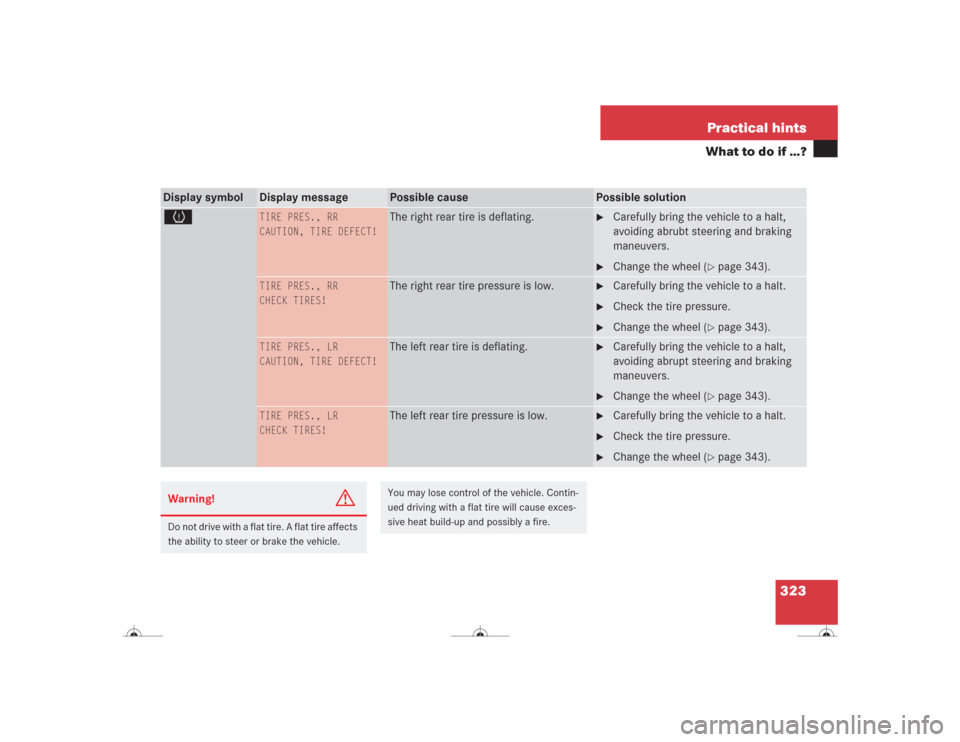
323 Practical hints
What to do if …?
Display symbol
Display message
Possible cause
Possible solution
H
TIRE PRES., RR
CAUTION, TIRE DEFECT!
The right rear tire is deflating.
�
Carefully bring the vehicle to a halt,
avoiding abrubt steering and braking
maneuvers.
�
Change the wheel (
�page 343).
TIRE PRES., RR
CHECK TIRES!
The right rear tire pressure is low.
�
Carefully bring the vehicle to a halt.
�
Check the tire pressure.
�
Change the wheel (
�page 343).
TIRE PRES., LR
CAUTION, TIRE DEFECT!
The left rear tire is deflating.
�
Carefully bring the vehicle to a halt,
avoiding abrupt steering and braking
maneuvers.
�
Change the wheel (
�page 343).
TIRE PRES., LR
CHECK TIRES!
The left rear tire pressure is low.
�
Carefully bring the vehicle to a halt.
�
Check the tire pressure.
�
Change the wheel (
�page 343).
Warning!
G
Do not drive with a flat tire. A flat tire affects
the ability to steer or brake the vehicle.
You may lose control of the vehicle. Contin-
ued driving with a flat tire will cause exces-
sive heat build-up and possibly a fire.
Page 325 of 418
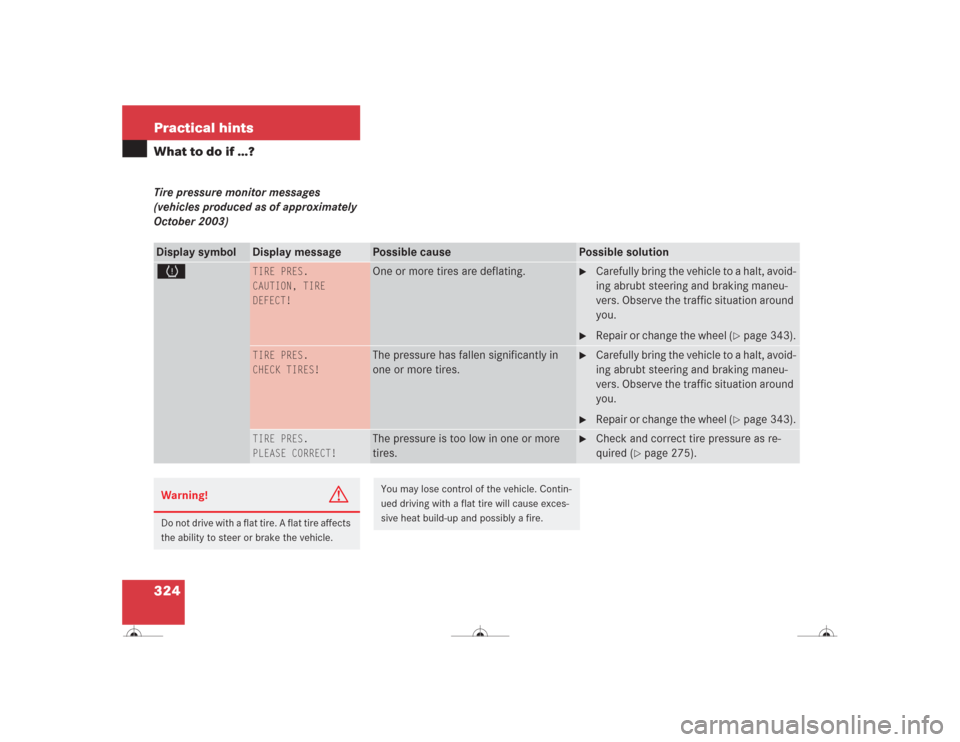
324 Practical hintsWhat to do if …?Tire pressure monitor messages
(vehicles produced as of approximately
October 2003)Display symbol
Display message
Possible cause
Possible solution
H
TIRE PRES.
CAUTION, TIRE
DEFECT!
One or more tires are deflating.
�
Carefully bring the vehicle to a halt, avoid-
ing abrubt steering and braking maneu-
vers. Observe the traffic situation around
you.
�
Repair or change the wheel (
�page 343).
TIRE PRES.
CHECK TIRES!
The pressure has fallen significantly in
one or more tires.
�
Carefully bring the vehicle to a halt, avoid-
ing abrubt steering and braking maneu-
vers. Observe the traffic situation around
you.
�
Repair or change the wheel (
�page 343).
TIRE PRES.
PLEASE CORRECT!
The pressure is too low in one or more
tires.
�
Check and correct tire pressure as re-
quired (
�page 275).
Warning!
G
Do not drive with a flat tire. A flat tire affects
the ability to steer or brake the vehicle.
You may lose control of the vehicle. Contin-
ued driving with a flat tire will cause exces-
sive heat build-up and possibly a fire.